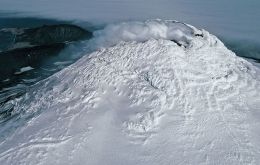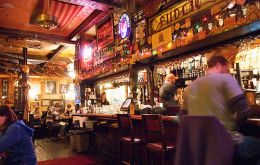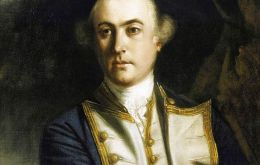MercoPress. South Atlantic News Agency
Tag: Saunders island
-
Thursday, August 15th 2019 - 07:30 UTC
Falklands' Day, recalls when John Davis first sighted the Islands on 14 August 1592

Falklands Day is the celebration of the first sighting of the Falkland Islands by John Davis in 1592, and is commemorated on 14 August. It was once seen as the National Day of the Falklands but has largely been replaced by Liberation Day which commemorates the end of the Falklands War.
-
Wednesday, July 3rd 2019 - 18:51 UTC
South Sandwich Islands hold one of the world's enduring eight lava lake in a crater

Satellite pictures confirm there is a persistent lava lake inside the crater of a remote British Overseas Territory (BOT) volcano. Few enduring lava lakes are known globally; the one at Mount Michael on Saunders Island in the South Atlantic may be only the eighth such example.
-
Tuesday, January 15th 2019 - 06:53 UTC
Falklands in The New York Times list of Places to Visit

On 9 January, The New York Times published a multimedia report with a list of 52 Places to visit in the world. In position 23 figures the Falkland Islands with the following description, emphasizing, “five kinds of penguins easier to reach”. The report is credited to Nell McShane Wulfhart.
-
Saturday, January 21st 2017 - 09:08 UTC
Vogue exploring the Falklands: Island hopping at the end of the world

Vogue magazine in its Living section, dedicated a well illustrated piece to the Falklands and to South Georgia, underlining its untouched beauty. Written by Lane Nieset, it offers five travel options, four in the Falklands and one in South Georgia.
-
Sunday, February 1st 2015 - 23:51 UTC
Falklands' community enjoys 250th anniversary celebrations

Saturday 31st January saw the culmination of a week of celebrations in the Falkland Islands commemorating the 250th anniversary of the Union Flag being raised on Saunders Island. Commodore John Byron placed the flag in 1765 signifying the start of British rule in the Falkland Islands.
-
Thursday, January 29th 2015 - 19:53 UTC
Falklands “Time Capsule” to celebrate 250th anniversary of flying the Union Flag in the Islands

As part of the celebrations of the 250th anniversary of the Union Flag being raised by English Commodore John Byron in the Falkland Islands, on 21 January 1765, more precisely on Saunders Island, a ceremonial sod of turf was raised on the site for a “Time Capsule” to be buried.
-
Wednesday, December 3rd 2014 - 09:14 UTC
Falklands prepare to celebrate 250 years since the Union Jack was first raised

The Falkland Islands are preparing to celebrate in 2015 is the two hundred and fiftieth year since Britain took possession of the Islands, when on January 23, 1765 Commodore John Byron raised the Union flag at Port Egmont on Saunders Island.
-
Tuesday, May 6th 2014 - 06:26 UTC
NASA catches images of volcanic activity in South Sandwich Islands

The South Sandwich Islands, in the far southern Atlantic Ocean, are often shrouded with thick cloud, making it difficult to view the region from space. Sometimes, however, the use of false-color imagery can be used to reveal events that would otherwise be obscured under cloud cover.
